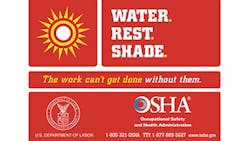Water. Rest. Shade. Three simple words – when put into practice by employers – can make a huge impact on the health of outdoor workers as summer weather heats up.
OSHA earlier this month announced that it’s launching its annual campaign to protect outdoor workers from heat illness. Now in its fourth year, the campaign aims to raise awareness and educate workers and employers about the dangers of working in hot weather and provide resources and guidance to address these hazards.
Workers in outdoor industries such as agriculture, construction, landscaping and transportation face the highest risk.
"Heat-related illnesses can be fatal, and employers are responsible for keeping workers safe," U.S. Secretary of Labor Thomas Perez said. "Employers can take a few easy steps to save lives, including scheduling frequent water breaks, providing shade and allowing ample time to rest."
Thousands of employees become sick each year, and many die from working in the heat. In 2012, there were 31 heat-related workplace deaths and 4,120 heat-related workplace illnesses, according to OSHA.
Labor-intensive activities in hot weather can raise body temperatures beyond levels that normally can be cooled by sweating. While heat rash or heat cramps are among the early signs of heat illness, it can escalate quickly to heat exhaustion and then heat stroke if simple preventative measures are not followed.
The agency notes that heat illness disproportionately affects those who have not built up a tolerance to heat (acclimatization), and it’s especially dangerous for new and temporary workers.
“Acclimatization is a physical change that the body undergoes to build tolerance to heat, and it is a critical part of preventing heat illnesses and fatalities,” OSHA Administrator Dr. David Michaels said. “Over the past three years, lack of acclimatization was the cause in 74 percent of heat-related citations issued. Employers have a responsibility to provide workplaces that are safe from recognized hazards, including outdoor heat.”
Last year, OSHA issued 11 heat-related citations. In some of the cases, the employer and staffing agency were cited because temporary workers were involved.
OSHA Resources
OSHA said it has developed heat-illness educational materials in English and Spanish, as well as a curriculum to be used for workplace training, also available in both English and Spanish. A Web page provides information and resources on heat illness – including how to prevent it and what to do in case of an emergency – for workers and employers.
OSHA also has released a free application for mobile devices that enables workers and supervisors to monitor the heat index at their worksites. The app displays a risk level for workers based on the heat index, as well as reminders about protective measures that should be taken at that risk level. Since its 2011 launch, more than 130,000 users have downloaded the app, according to OSHA. Available for Android-based platforms and the iPhone, the app can be downloaded in English and Spanish.
In developing its inaugural national campaign in 2011, federal OSHA worked closely with the Cal/OSHA and adapted materials from California’s successful campaign.
OSHA also is partnering with the National Oceanic and Atmospheric Administration to incorporate worker safety precautions when heat alerts are issued across the nation. NOAA will include pertinent worker safety information on its heat watch Web page.
